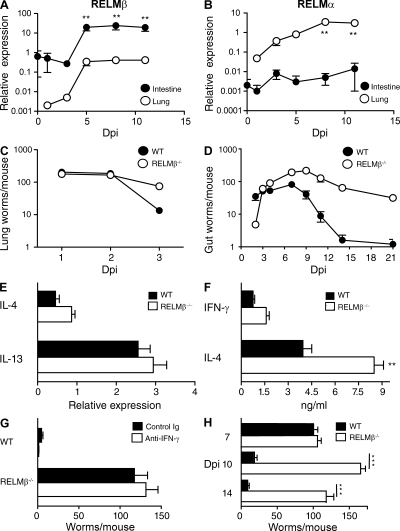Figure 2.
Intestinal RELM-β expression is important for N. brasiliensis and H. polygyrus expulsion. (A and B) RELM-β (A) and RELM-α (B) mRNA were quantitated by real-time PCR in intestinal and lung tissue after N. brasiliensis infection. Results are representative of two independent experiments with mean ± SE. n = 6–8 mice/group. **, P < 0.01. (C) Lung worm burden in N. brasiliensis–inoculated WT and RELM-β−/−. Mean ± SE is shown of five to six mice per group. Error bars are too small to be seen. The experiment was performed twice. (D) Intestinal worm burden in N. brasiliensis–inoculated WT and RELM-β−/−. Mean ± SE is shown of 8–10 mice/group. The experiment was performed four times. (E) Real-time PCR analysis of IL-4 and IL-13 in gut mRNA 7 d after inoculation. Mean ± SE is shown of five to six mice per group. (F) Serum levels of IFN-γ and IL-4 measured by IVCCA 10 d after inoculation. **, P < 0.01. (G) Intestinal worm burden of WT and RELM-β−/− mice 10 d after inoculation in mice treated with anti–IFN-γ (XMG-6) or isotype control mAb (GL113). (H) Intestinal worm burden 7, 10, and 14 d after second infection of WT or RELM-β−/− with H. polygyrus. Dpi, days post inoculation. The error bars indicate the SE of five to six mice per group. The experiment was performed four times. ***, P < 0.001, compared with WT.

